The Red Fox Elbrus Race
The wind was ice cold and strong enough to bring me out of balance, it felt like −20 °C. Me and my friend Christoph Moser were approaching the summit plateau of Mt. Elbrus (5642 m a.s.l.) with aluminum crampons on our feet and light ski-mountaineering racing skis on our backs. It was four o’clock in the afternoon and the May sun was shining brightly above the cumulonimbus clouds. This is quite late in the day to be at nearly 5500 m a.s.l., and 3000 m above the valley. But following a long travel we enjoyed being up here more than anything else. In fact, we were quite surprised that we had reached this high elevation after starting ‘spontaneously’ at the “Barrels” (Garabashi) camp at 3800 m a.s.l. at noon only in order to do ‘a little acclimatization trip’. After a few more minutes of breathing hard we reached the summit and were extremely stoked to be there, on the top. We took photos, jumped around out of joy and admired the view. Then came the best part: we skied all the way down on our fast and light skis. Acclimatization does not need to be slow and boring.
The race
The idea of the “Red Fox Elbrus Race” is simple and it stems from times when the Russian military organized a competition to recruit the best alpinists for their Himalaya expeditions: To reach the summit of Mt. Elbrus (5642 m a.s.l.) as fast as possible on foot, starting at the ski-resort village of Azau at 2300 m a.s.l., covering 3350 m of vertical gain and 14 km in distance.
But that is not everything: The race is organized as an entire “outdoor festival”, spanning over one week. It starts with a ski mountaineering race going up to 4200 m a.s.l., an opening ceremony with traditional songs and dances, followed by a Vertical Kilometer race going from 2400 to 3450 m a.s.l. one day later and culminates in the actual Elbrus Race from the village to the summit, topped off by a snowshoe race the day after, a closure ceremony and party.
The Garabashi
After our acclimatization trip on skis to the summit, I decided to sleep at the Garabashi high camp at 3800 m for one night in order to acclimatize more. There, I had the pleasure to enjoy dinner with some of the Russian volunteers and organizers, including the CEO of Red Fox, the outdoor company which is the main sponsor of the event. This ‘old school’ alpinist had made his way up here from Moscow to meet the people and see the event unfold – he himself had taken part in several Himalaya expeditions. Although the cooking facilities up in the container huts were very basic the food was abundant and tasty. Nearly no one (except for the CEO) spoke English, so I had to get by with sign language. The views of the Russian and Georgian Caucasus mountains were spectacular. Some important peaks like Shkhara (5200 m) and Ushba (4700 m), also called “the Matterhorn of Georgia”, could be admired in the evening light. The sleep was not really deep, but who cares; 1.5 years after climbing with friends in Georgia I was back in the wild Caucasus!
The international contenders
On the next day I did some easy ski mountaineering training up to 4300 m to get further used to the altitude and then skied down to Azau to enjoy the warmth of our hotel, more food and the company of new international friends: An entire team of ski mountaineers from Catalunya, Spain, was there, two of them winning the Elbrus ski mountaineering race. There were also two outgoing Italians, Nico Valsesia and Andrea Cubisino, who hiked up towards the summit literally every day (but always had to turn around). Further there were people from Germany, Mongolia, Kazakhstan, Kyrgyztan, Nepal, and most importantly Ecuador. Karl Egloff, the record holder of Mt. Kilimanjaro and of Aconcagua had arrived together with his friend Nicolás Miranda, with no smaller goal than challenging the record time set on Elbrus by Vitaly Shkhel, a Russian farmer and soldier living not far from Elbrus. I was very glad to meet some athletes and new friends with whom I could talk Spanish, Italian and Swiss German (Karl Egloff is half Swiss), and exchange ideas about the material we would use for the Elbrus race. But first, we had to pass the qualification for the main race: The Vertical Kilometer (VK) Race on Wednesday.
The Vertical Kilometer
I had a strong cold since I slept at altitude – a consequence of the fast acclimatization and a lot of travelling during the days prior to coming to Russia (France – Italy – Swiss Alps). Because the VK race was mandatory to be able to take part in the Elbrus Race, the decision to take part or not was easy: I had to start and see what happens. I used my light and grippy Dynafit running shoes, but decided not to take microcrampons because the snow was soft enough and not slippery, I thought.
At the start, we ran off hard – Karl Egloff leading for the first 200 metres. Then Vitaly Chernov (Russia), Oriol Cardona (Catalunya/Spain) and me took over, moving away from the others with our group of three. Nearly 200 people were running behind us in our small track in the snow – I felt hunted! I had trouble breathing due to my full nose, and the snow was more slippery than expected. When Vitaly slowed down a bit, I decided to pass him and take the lead. It was hard because there was no good track yet. Oriol followed me closely. He seemed very strong and I could not move away from him. Higher up I had to let him pass, because I kept sliding in the snow at every step. We were above 3000 m a.s.l. now, but the sun was hot and the sweat running down our faces. Soon we approached the last steep uphill to the finish line. I went to the limit of what my body could do, but Oriol sprinted faster than I could imagine – into the finish – and won by 20 seconds. I was just glad to be finished, very pleased with second place. My time for the 1050 vertical meters and 5 kilometers was 46 minutes.
Rest day
A day of doing not much and relaxing followed. The little village of Azau is perfect for this, as there is not much to do. It is squeezed in-between very steep mountain slopes with potential avalanche and rockfall hazards. The village is composed of a few hotels and restaurants, a market with local souvenirs and furs, and, most importantly, one food shop that repeatedly ran out of bananas and big water bottles when the participants of the Elbrus Race went to shop there. I can still smell the ‘Shashlik’ smoke from the little restaurants that usually invaded the entire public square. Some bored soldiers with big arms are watching the frontier to Georgia – do not ski tour all the way up to the ridgeline (= border!), and always carry your border permit with you – otherwise you can get shot.
We spent the day eating shashlik, drinking water (and beer), eating bananas and with a little jog in the beautiful alluvial floodplain forest just below the village together with Christoph, Oriol, Karl, and the two Italians, Nico and Andrea. In the evening there was a race briefing with explanations about the mandatory material – all translated into English. Discussions about which material to take, microcrampons or real crampons, a warm or not-so warm jacket, et cetera, carried on until we went to bed.
Race day
Then it was on. Today was race day. Start was at seven o’clock in the morning. We jogged around nervously to warm-up a little. But a long warm-up was not required, because the race was long enough to get warm. Then we started. The course went uphill immediately, first on gravel, then on the ski piste. After a few minutes the leaders’ group had already formed: Karl Egloff (Ecuador), Oriol Cardona (Catalunya/Spain), Vitaly Shkhel (Russia, record holder), Dimitry Mityaev (Russia), and me. We hiked or jogged as the slope allowed in a quite steady rhythm, pushing each other to go faster. The first 1000 vertical meters were done in about 50 minutes. Before 8:30 we reached the changing zone near the Garabashi camp at 3850 m, where we were allowed to change shoes, eat, drink and pick up a small backpack. Vitaly and Karl had light but insulated running shoes. They did not need to change and after a few seconds they continued uphill. I decided to change my running shoes for light mountain boots with crampons on so I did not spend energy on sliding and did not risk freezing my toes off, which I paid for with heavier weight. I ate some banana and drank a cup of tea – the volunteers helped me very kindly with the gear change.
Oriol Cardona and the other Russian, Dimitry, also left the changing zone before me, so I was the last one of our ‘leader group’ to leave. Now we power-walked in slightly loose, slippery snow and the five of us were spread out over a distance of 200 m. I felt quite good, and up to 5000 m a.s.l. I did not even feel the altitude very much. But it’s here where the real race started. At high altitude everything is different; the pure endurance becomes somewhat less important. What counts most is to be experienced in moving at high altitude, and well acclimatized. Around that height of 5000 m I put on a warm primaloft jacket. Oriol seemed to suffer from the altitude and I tried to cheer him on as I passed him. Vitaly was still visible in front of me. But the higher we climbed, the faster he went relatively to me – he was obviously much better acclimatized. Karl seemed to be way ahead now. We kept passing people who had started their race before us at the Garabashi camp – the start of the “amateur race”. As we were passing, many were encouraging us in Russian on the way: “Davai, davai!”, and I responded “spasiba” (thank you). I tried to get into my “high-altitude walking pattern”, with rhythmic breathing synchronized to my steps, and breathing consciously, as deeply as possible. I estimated that we were still climbing at approximately 800 vertical meters per hour – that was breathtaking both literally and figuratively!
At the saddle at 5350 m a.s.l. the volunteers served me some hot tea. Because of the numerous ‘early starters’ and other alpinists, it was very hard to see where the other competitors were. But now it was not far anymore: the last steep face, the summit plateau – and YES! – I was in 3rd position now! Karl came running down from the summit to come cheer me on for the last 20 meters, with a big winner smile on his face. Then I was there. The feeling to be on top was unbelievable: summit joy and race-finish joy at once! I had climbed the 3350 vertical meters in 3h 56 minutes, faster than I could have hoped. Vitaly was already on the way down, but when Nicolás Miranda arrived in 4th position (10 minutes after me), we had our own little Ecuadorian-Swiss celebration up there, with the photographers and some volunteers as our only witnesses. It was relatively warm on the summit, maybe −8 °C, but it started snowing slightly now.
Karl had won the race in 3 h 45 min, but he did not manage to break the speed record of 3 h 28 min, mainly due to the snow conditions and the many people he had to pass on the way up. Soon we ran down in order to avoid being exposed to the thin air for too long after this maximum effort. We greeted racers on the way and checked if someone needed help. At the barrels camp we got spoilt with good and filling Russian food.
Thoughts
When I came back down to the village I was sorry to hear that my friend Chris had abandoned the race right after the start. He did not feel well and he was afraid something could happen, even more as he had his wife and kids waiting for him at home. Chris is a good mountaineer and endurance athlete. His example suggests that it is good to listen to your own feelings: although Mt. Elbrus is a technically easy mountain, racing at high intensity at such an altitude can be dangerous. Only well prepared people with mountain experience should consider undertaking this adventure. But if one is well prepared, it may end up being one of the most beautiful race experiences in your life.
We concluded our trip with even more food and celebrations in the village of Azau together with our new international friends, and a smooth travel back home with two medals, an official “Russian Alpinist” certificate and many good memories in the luggage.
–––
Homepage: http://elbrus.redfox.ru/en
Visa: Apply for a visa at least 3 months prior to the race. The organizer can provide you assistance with the visa.
Travel: Fly to Moscow and on to Mineralnye Vody. There, the race organizers can arrange a pick-up service for you. Beware, some drivers go very fast and cover the route in 2 h instead of 3–4 h, even by night and rain!
Accommodation: The organizers can arrange for hotel accommodation in the village of Azau, including breakfast and dinner.
Acclimatization: Best is to arrive somewhat pre-acclimatized (from the Alps). If you want to acclimatize there, you can ask to stay at the barrels (Garabashi) camp for cheap. Take a warm sleeping bag along! During the week of the race, the organizers provide food at the barrels camp.
Ski resort: The Elbrus Ski Resort is worth taking the skis along. It goes up to an elevation of about 4000 m and has stunning views of the Caucasus Mountain range. If you participate in the race, you can buy cheaper lift passes.
–––
Note of the editor
Pascal Egli took part in the Red Fox Elbrus Race 2016. Karl Egloff won the race in 2017 and set a new course record, 3:24:14. Czech translation of the article is coming out in July 2017 (B Magazine, Issue 4). All photos are by Oleg Chegodaev.
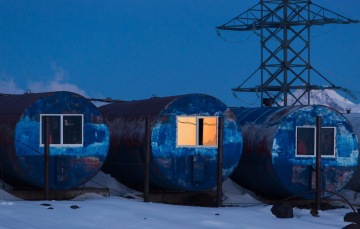
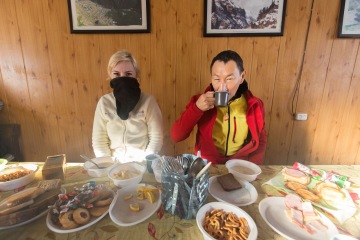
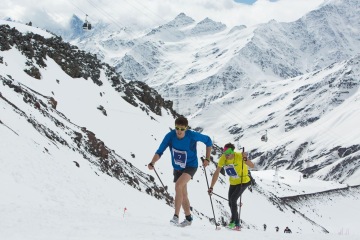
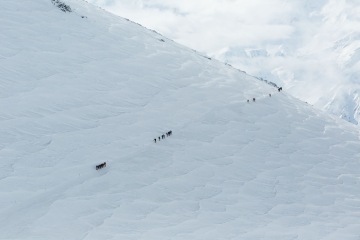
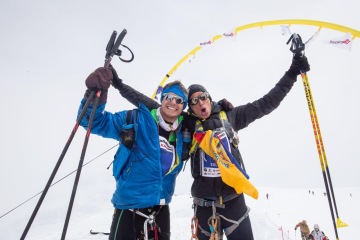
Photos © Oleg Chegodaev